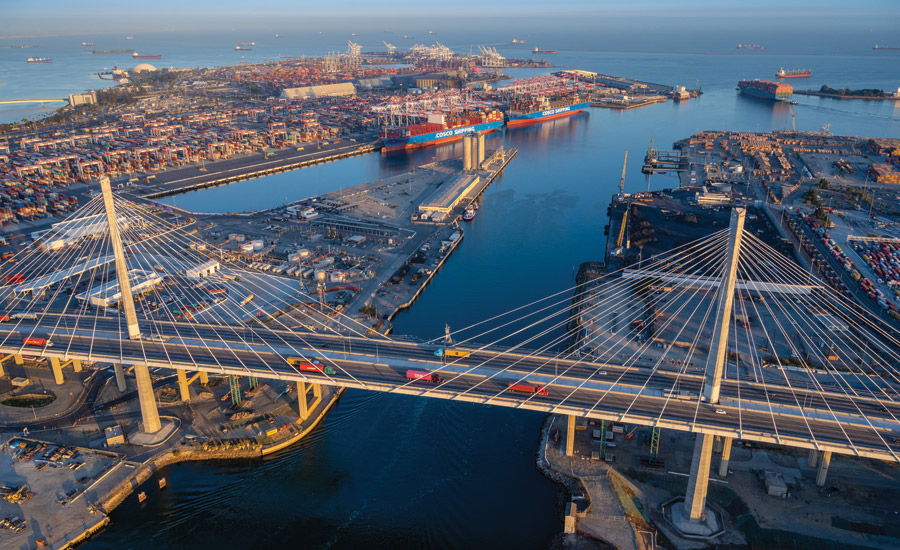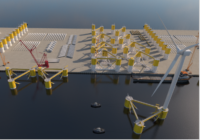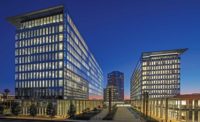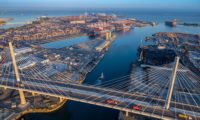Is it possible to be one of the nation’s largest and most efficient multimodal seaports and also the greenest?
The Port of Long Beach is committed to proving that achieving such lofty, sometimes competing goals is not only possible, it’s also practical.
Already handling trade valued at $200 billion per year—and approximately 20% of all loaded containers moving through U.S. ports—the Port of Long Beach has in recent years invested billions in modernizing existing facilities and infrastructure with sustainably sound features such as integrated shoreside power for berthed vessels, dozens of charging stations across its 3,520-acre landside property for heavy-duty electric vehicles and upgraded land access with the nation’s second-tallest cable-stayed bridge.
Each effort contributes to an overarching aim to become the world’s first zero-emission seaport, a goal expressed earlier this year by port CEO Mario Cordero.

A three-project, $100-million program will soon eliminate bottlenecks within the port’s existing 100-mile rail system.
Photo courtesy of the Port of Long Beach
Now the port is set to invest $2.4 billion over the next decade in a capital program that aims to maximize rail transportation’s efficiency and environmental benefits. The effort begins with the expected summer 2024 start of construction on the centerpiece $1.5-billion Pier B On-Dock Rail Support Facility, which will increase container volume handling capacity by a factor of three—to 4.7 million 20-ft equivalent units (TEUs) a year—through the addition of approximately 140,000 ft of storage and arrival/departure track, a 30 locomotive fueling depot and a full-service staging area to assemble and break down trains up to 10,000 ft long.
Sean Gamette, the port’s managing director for engineering services, says that while the agency’s capital programs span all transport modes, rail has been a focus area for several years. Examples include the soon-to-be-completed three-project, $100-million program to eliminate bottlenecks within the port’s existing 100-mile rail system. These improvements, Gamette says, will allow the port to add another daily outgoing train to an already busy daily schedule of 13 inbound and outbound trips.
“It’s been particularly impressive to observe their consistent approach to addressing regional and national challenges with collaborative and innovative strategies.”
—Tom Kim, Transportation Group Area Manager, HDR
Nearly $643 million in federal and state funding, including a $283-million U.S. Dept. of Transportation Mega Program grant awarded last December, will augment the port’s own investment in the Pier B project.
“It allows us to build something monumental like this but also continue on other priorities so that nothing is left out of the picture,” Gamette says, adding that the port expects to formally award the Pier B construction contract in May.
Sustainability also underscores a $200-million deep draft navigation channel deepening project, set to start in 2027. The partnership with the U.S. Army Corps of Engineers will allow large vessels to enter and leave the port fully loaded under most any weather and tidal conditions instead of idling at berth or offshore with auxiliary engines. Another $400 million has been programmed over the next decade for waterfront structure maintenance repair, rehabilitation and upgrade work.
Such strong emphasis on sustainability is hardly a new phenomenon at the port, according to HDR transportation group area manager Tom Kim, who has been involved with planning the Pier B project since the mid-1990s.
“It’s been particularly impressive to observe their consistent approach to addressing regional and national challenges with collaborative and innovative strategies,” Kim says. He adds that these efforts demonstrate “a practical yet ambitious pathway to meeting environmental goals while enhancing efficiency and capacity, reflecting their long-standing commitment to operational excellence and innovation.”

Dozens of charging stations have been installed across the port’s 3,520-acre landside property for heavy-duty electric vehicles.
Photo courtesy of the Port of Long Beach
Priorities and Partners
The key to keeping such broad-based infrastructure programs in sync, Gamette says, is a strategic plan that captures a vision for operational excellence and environmental stewardship and aligns actionable goals and objectives across the organization.
“Without the broad alignment in our strategic plan,” Gamette says, “it would be hard to balance those goals.”
Proposed capital plan projects are viewed through “a sustainability lens” to ensure each project incorporates elements that reduce environmental impact, Gamette adds.
There must also be room for flexibility to accommodate the unexpected, as was the case when the global coronavirus pandemic disrupted both the port’s operations and the flow of cargo into and out of the facility. For that reason, Gamette says, the capital program has built-in resiliency mechanisms that allow the seamless redirection of resources to priority projects.
“They have a vision, and they follow it to make sure they’re a fair employer.”
—Tony Chemali, Vice President of Construction Management, Jacobs
He points to the 2021 completion of the three-phase $1.5-billion Long Beach Container Terminal at Middle Harbor, a 300-acre facility powered nearly entirely with electricity. The 4,200-ft-long wharf allows up to three 14,000-TEU ships to plug into shore power and be worked simultaneously with more than 100 electrified automated guided vehicles transporting containers between the docks and the yard.
Gamette says none of the port’s capital project successes would have been possible without the support of its engineering consultants and contractors.
“They’ve been right there with us, helping us execute those priorities,” he says. “We do have challenges from day to day, but through collaboration, we resolve them with good solutions.”
The foundation of this relationship, notes Min Zavarella, president of operations for Pinner Construction Co., is that the port doesn’t view construction as a commodity.
“They’re like a member of your own team,” says Zavarella, whose firm recently completed a $109-million project to construct two fire station boathouses for the port’s state-of-the-art fireboats. “They believe in being fair and that the answer to a question isn’t always just no. They recognize that matters brought up during construction need to be vetted, understood and resolved, and [they] are always looking to find the fair adjudication of any matter.”
Tony Chemali, vice president of construction management for Jacobs, adds that the port also regularly engages its construction partners to find ways to do things better, from capturing lessons learned from previous projects to improving change order and payment processes.
“It all boils down to their culture and their leadership vision, from top down,” says Chemali, who was involved with the Middle Harbor project. “They have a vision, and they follow it to make sure they’re a fair employer.”
That includes ensuring a reliable supply of coveted craft labor for these ambitious infrastructure efforts. In early 2023, the port and the Los Angeles/Orange Counties Building and Construction Trades Council finalized a 10-year project labor agreement for projects valued at $5 million or more.

In 2023, the port released plans for a floating offshore wind facility, Pier Wind, for the manufacture and assembly of offshore wind turbines. It would be the largest such facility at any U.S. seaport.
Rendering courtesy of the Port of Long Beach
Maintaining Momentum
One thing Gamette wishes the port had more of is greater project delivery flexibility. By state law, projects are largely limited to design-bid-build. Legislative exceptions were granted to use design-build for efforts such as the $520-million civic center development collaboration with the city of Long Beach as well as the $1.5-billion Long Beach International Gateway Bridge, previously known as the Gerald Desmond Bridge.
Gamette believes that alternative project delivery would benefit development of Pier Wind, the port’s proposed 400-acre offshore terminal that would be the largest U.S. facility specifically designed for the staging and integration of floating offshore wind turbines. He adds that a sustainability focused seaport—backed by Southern California labor and manufacturing base able to meet operational demands—is the natural location for a project that would also support the state’s goal of producing 25 GW of offshore wind energy capacity by 2045.
“The turbines’ size requires a port without air or deep draft restrictions,” Gamette says of the project, which in a best-case scenario could begin construction as early as 2027. “We’re uniquely situated to have a terminal like this.”
There are other ideas on the horizon, Gamette says, such as exploring the incorporation of microgrids for enhanced operational resilience and potential use of hydrogen to power equipment and vehicles. There’s also the potential of using existing vacant land for emission- and efficiency-based development efforts that could be led by the port or its terminal operators.
“We aim to be the port of choice,” he says. “We want to be developer and owner of choice too.”





Post a comment to this article
Report Abusive Comment